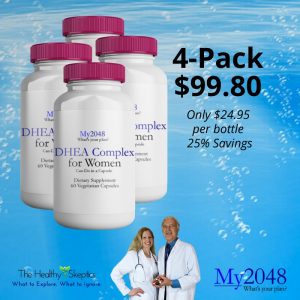DHEA, Women's Health
Hey, ladies, DHEA is Can-Do in a capsule
Hey, ladies, DHEA is Can-Do in a capsule
Dehydroepiandrosterone (DHEA) is known as the hormone of resilience to the Navy SEALs and many women who enjoy its benefits. DHEA, made primarily in the adrenal glands and brain, is the body’s most comprehensive repair signal. Our levels are highest during our prime years of life ages 20 to 30, empowering us with stamina, confidence and resilience. Unfortunately, part of the aging process is the decline in DHEA starting at age 35. This decline becomes more serious with each decade, until at age 70, the average woman is producing only about 10% of what she made in her 20’s.
 Consider the story of Sally, a 37-year-old woman who came to me complaining of fatigue and what she called “the blahs.” For a few years, she found that she just couldn’t do things the way that she had in the past. Whereas she used to be able to work all day and still have good energy in the evenings, now she felt exhausted by 3 PM. She also felt physically weaker, struggling at times to carry groceries from the car. Everyday tasks that previously caused her no worry, now seem overwhelming. Just the thought of sitting down to take care of her bills seemed a huge burden to her.
Consider the story of Sally, a 37-year-old woman who came to me complaining of fatigue and what she called “the blahs.” For a few years, she found that she just couldn’t do things the way that she had in the past. Whereas she used to be able to work all day and still have good energy in the evenings, now she felt exhausted by 3 PM. She also felt physically weaker, struggling at times to carry groceries from the car. Everyday tasks that previously caused her no worry, now seem overwhelming. Just the thought of sitting down to take care of her bills seemed a huge burden to her.
But there was hope for Sally. We had her serum DHEA-sulfate (DHEAS) level tested. Her result was 52 µg/dL, the level of an unhealthy 65-year-old woman. No wonder Sally felt old and tired.
She began taking DHEA for Women, containing 15 mg of DHEA. Because she experienced no acne or irritability (uncommon but possible side effects), she increased her dose to 30 mg a day. Three days later, Sally noticed that her joint aches were less. One month later, she found that she didn’t crave naps in the afternoon. Looking in the mirror, she was pleased to see better muscle definition in her arms and shoulders. By the third month of taking DHEA for Women, she reported that she was more patience with her teenage sons, was actually looking forward to exercise, and was enjoying a better sex drive to share with her husband.
All of these improvements were noticed by her family and friends, so it was not surprising that Sally became a “DHEA evangelist.” She explained to her friends that testing for DHEAS was one way to begin the DHEA adventure, but it’s not necessary. You can start as she did with 15 mg/day and evaluate the benefits, increasing gradually as you start to feel stronger and more confident. Then, at your annual physical exam, simply tell (do not ask) the doctor to include DHEAS in your routine blood chemistry. The healthy range for women is 250 to 350 µg/dL.
When Sally retested her DHEA sulfate level, (without taking any DHEA 12 hours before the test) her new result was 264 µg/dL, reflecting the increased energy, confidence and stamina that this hormone helps to generate. Sally never misses a day of taking her DHEA for Women. I remind her that DHEA is not a magic bullet. Optimum health requires good nutrition, regular exercise and proper sleep. “Thing is,” Sally remarked, “DHEA makes all of those things easier and more enjoyable. It’s my Can-Do capsule.”
References:
- Journals of gerontology: biological Sciences, 2017, volume 72, number six, pages 747-753. “Precipitous dehydroepiandrosterone declines reflect decreased physical vitality and function.“ Danielle N. Rendina, Carol D. Ryff, and Christopher L. Coe.
- The Metabolic Makeover: it’s all about energy! by Stephen Cherniske and Natalie Kather, MD
